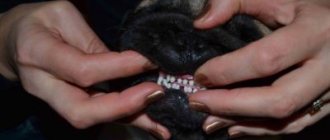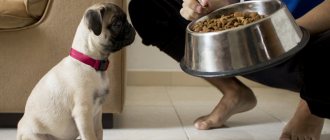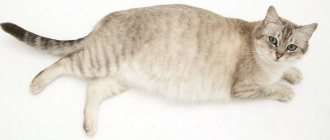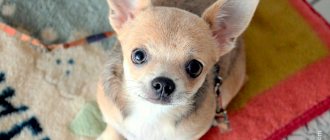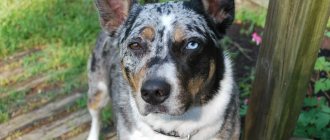What to do?
Caring for a paralyzed dog is not an easy task, both physically and mentally. You must realize and accept the fact that paralysis, as a rule, is an irreversible process. In order for your pet to feel happy, despite its health condition, you must promptly solve problems typical for “lying” dogs.
- Hygiene. A paralyzed dog cannot get out and put its body in order. In addition, the problem of pollution is overshadowed by fecal and urinary incontinence. To prevent your dog from suffering in its own waste, wash it once every few days. You can also use dog or baby wipes.
Reference! Regular washing causes the dog's skin to lose its natural protective layer and become dry. To avoid problems, ask your veterinarian to recommend moisturizing creams or emulsions.
- Protection from parasites. Even if a dog does not go outside, this does not mean that it is protected from flea bites. Your pet can catch the infection from other pets, or you yourself can bring it home on your clothes or shoes. Use water-resistant antiparasitic products.
- Dryness and comfort. Since lying dogs walk under themselves, the problem of dampness, dirt and unpleasant odor from the bedding arises. To make caring for your pet easier, use disposable diapers, diapers or waterproof panties.
- Fighting bedsores. Bedsores form in areas that receive the most pressure: the sides, elbows, hips, and hocks. If the problem already exists, only a qualified doctor can solve it. It is likely that protective dressings with ointment will be required. You can reduce the likelihood of bedsores using a special orthopedic bedding.
- Walking equipment. A dog with pelvic paralysis can walk using its front legs. To prevent your pet’s muscles from atrophying from a passive lifestyle, think in advance about a walking device: it could be a cart, a stroller, or a supporting harness with a handle.
Rehabilitation of a paralyzed animal
Atrophy is not always an irreversible process. Sometimes regular exercises and procedures help to partially or completely restore mobility to the limbs, as well as restore at least an unconscious “spinal gait”.
For example, if paralysis is caused by injury, then in some cases the return of limb functionality is simply a matter of time. If these are some serious progressive diseases, then, unfortunately, only supportive therapy remains. Your veterinarian will tell you about the type of illness and prospects for rehabilitation.
Hydrotherapy and massage have worked well as restorative exercises. You can take your animal to the hospital for procedures, but it’s not that difficult to handle this on your own. Take all the necessary instructions from your doctor and practice in the bathtub or open water, reminding your pet how to move its paws. Regularly gently stretch and flex paralyzed limbs to restore blood flow and try to restore functionality.
If definitive atrophy is diagnosed, the animal can still continue to live and move around. Typically, cats and dogs can only use their front paws, pulling the rest of their body along with them. It's physically difficult, but they just do it and that's it. To make it easier for them to move and to overcome obstacles in the form of thresholds and stairs, you can purchase a special stroller for disabled animals. It is quite light and does not restrict movement too much. The pet will walk with its front paws, while its hind paws will be securely secured in the stroller. It is advisable to combine this method of movement with other physical exercises.
Don't let the disease take its course. In such a situation, you need as much love, care and effort as possible to fight for your pet and, together with the doctors, try to return him to a full life.
What are the different feeding methods?
Paralyzed dogs are able to eat on their own, however, certain adjustments will have to be made to their usual menu.
First of all, you must eliminate all “drying” and salty foods from your diet. They contribute to the formation of edema, as they force the dog to drink more and retain fluid in the body. This puts stress on the kidneys and heart.
If the animal is accustomed to dry food, it will also have to be abandoned.
The ideal product for paralyzed dogs is wet pate food or ground buckwheat porridge with lean meat and vegetables. Note! Before switching your dog from one diet to another, consult your veterinarian.
Massage and exercise
Physical exercises and light gymnastics are prescribed for pets who have hope of recovery. Few people know that disabled pets need a simple 5-minute massage every day. It is completely simple and consists of simply bending the limbs several times. If the cat's owner does not do this, the hind legs will stiffen and interfere with the animal's movement, as well as its ability to assume a normal position while resting.
Massage for disabled animals is the only way to slow down atrophy of the lower limbs. Below are a few more exercises to warm up your muscles:
- after basic flexion/extension of the limbs, you can simply tickle the paws, thereby helping to improve blood circulation in this area;
- massage of the front paws, shoulders and neck - due to the increased load on them, helps to avoid cramps and spasms;
- As a result of the immobility of the hind legs, the animal cannot scratch itself; the owner must take over this function and comb his entire body every day.
How to walk?
An animal that was previously active and mobile should not suffer from a lack of exercise, especially if the dog has mobile front legs. While walking, it is important to follow the following rules:
- Avoid overexertion. The dog should not get tired and overexert its muscles. Walks should be leisurely - at a pace that is comfortable for the pet. It is best to walk 2-3 times a day for 15-20 minutes, away from the commotion and other animals.
- Avoid injury and hypothermia. Make sure that your ward does not fall to the side, does not scratch the skin and does not introduce splinters. As a rule, regenerative processes in paralyzed dogs proceed much more slowly.
Carts or strollers
The problem of movement can be solved with the help of a special wheelchair: this is a two-wheeled device that resembles a wheelbarrow, on which the hips of a paralyzed animal are placed and secured.
According to reviews from owners, dogs quickly get used to wheelchairs and even begin to participate in active games.
Other devices and accessories
Second option: harness with handle. This is a device consisting of a lining, a belt and a handle with which you can support your pet in a standing position.
Rule four - fulfillment of the attending physician's prescriptions
Almost any disease diagnosed by a veterinarian must be comprehensively treated. The course of treatment includes a special diet and medication. Medicines can be in the form of drops, mixtures, tablets or capsules. It is extremely important to follow all recommendations of the veterinarian who diagnosed the animal. Of course, almost all dogs take medicine with great reluctance. The owner’s task is to contrive and give the necessary drug. You need to consult your doctor about whether it is possible to mix tablets or capsules with food and whether this will affect the overall effectiveness of therapy. If there are no contraindications, the tablet can be mixed with soft food.
In some cases, it will be more effective to place the tablet on the root of the tongue, closing the animal’s mouth and slightly raising its head. The dog will instinctively make a swallowing movement and eat the medicine. If the medication is in the form of an oral solution, it is simply poured into the mouth. The medicine is administered by pointing the syringe into the area between the molars of the lower and upper jaw. You can also sometimes use a special device - a tablet dispenser. It is quite easy to use, but is not suitable for all animals.
How to empty your bladder?
Many owners are simply lost, not knowing how to help their dog solve such a delicate problem. Don't be scared - with a little practice, you will learn how to empty your dog's bladder in one go. There are several methods, depending on the size and sex of the animal.
Females of small breeds
- Take your dog to the toilet.
- Squat down, placing your pet's front paws on your shoulder or knees, and holding the back of your body over the toilet bowl.
- Try to find your bladder: it feels like a small rubber ball filled with water.
- Gently press down on it, pushing the liquid towards the outlet.
- Make sure your bladder is empty.
- Clean your dog's fur with wet wipes.
Note! The most difficult thing is to learn to identify the bladder by touch. The first emptying of the bladder is best done under the supervision of a veterinarian.
Males
- Put your pet on a diaper or take it outside.
- Secure the dog in an upright position by lowering its butt onto your knee and holding it under your chest with your other hand.
- Place your free hand under your stomach and feel your bladder (it is located slightly above the base of your genitals).
- Squeeze the bubble in the same way as described above in the instructions for females.
- The urine will pass through the urethra as it should - it does not need to be pushed in any direction.
- Continue squeezing until it is completely empty, then help the dog get its body in order.
Large
In order to help a large dog empty its bladder, you need to make a special crossbar structure with fabric stretched between the posts, or use a harness.
- Secure the dog in a standing position on the harness. Another person or a special stable structure should help you with this.
- Use both hands, squeezing both sides of the bladder until it is completely empty.
Causes of paralysis in dogs
Paralysis and paresis are usually caused by problems in the spine or brain.
Intervertebral disc diseases
IVD is a spinal disorder that occurs when one or more discs between the vertebrae become irritated, slipped, swollen, or ruptured. This can cause damage to the spinal cord, which may or may not resolve with surgery. Unfortunately, some dogs with IVDD never fully regain function of the affected limbs or body parts and require special care throughout their lives. IVD is one of the most common causes of paralysis and paresis in dogs.
Spinal injuries
The injury can result in serious spinal cord injury, especially if the injury was a spinal fracture. Surgery can lead to a full recovery, but not all dogs will regain full motor function and will require special assistance.
Tumors
The dog may develop a tumor on or near the spinal cord that affects motor function. In addition, brain tumors can grow in the area of the brain that controls motor function. Some tumors can be treated with surgery, chemotherapy and/or radiation therapy. However, the tumor cannot be completely eradicated and continues to cause problems for the dog.
Inflammatory diseases
Infectious diseases and autoimmune disorders can cause inflammation of the tissues of the brain and spinal cord. This inflammation can lead to temporary or permanent paralysis or paresis. Medicines may help, but some dogs will be left with damage that limits motor function.
Congenital defects
Some dogs are born with one or more conditions that affect movement. This is often due to a malformation or abnormal development of the brain and/or spine.
How to help go to the toilet if you are constipated?
Constipation is a common problem among paralyzed dogs. Often, the problem is caused by inhibited functioning of the gastrointestinal tract and an incorrect diet (dry food, meat bones, baked goods).
The problem needs to be resolved together with a veterinarian. Often, your doctor may recommend adding flaxseed or vaseline oil to your diet. It will facilitate the sliding of stool through the intestines.
In the event that a plug occurs in the intestines, an oil or rinsing enema is used. You should not be afraid that this will somehow poison the animal’s body - all excess oil will come out naturally. Place a diaper under your dog in advance to avoid damage to the furniture.
Emergency care and care for a sick dog
To care for a sick dog, keep a first aid kit at home. There should be cotton wool, bandages, alcohol, brilliant green, etc.
If your dog has poisoning
First, give an emetic. For example, a solution of salt, soda and mustard, a teaspoon per liter of water.
Secondly, make sure your dog drinks plenty of fluids.
Make you swallow 2-4 tablets of activated carbon or other sorbents.
After this, urgently take him to a hospital.
If the veterinarian prescribes a cleansing enema
Prepare boiled water at room temperature. For small breeds, you can use a rubber bulb. For larger ones - a 0.5 liter Esmarch mug. When performing the procedure, place the animal on its side. First, lubricate the tip with Vaseline. Then carefully insert into the anus. Carry out this procedure in the yard to keep it clean.
For constipation, adding castor oil to your diet helps.
Caring for a dog with sprains and fractures
The animal experiences sharp pain, howls and squeals. Therefore, give a painkiller tablet, for example, Analgin. After this, apply an ice pack to the damaged area and take it to the hospital. Make sure there is no pressure on the injured paw.
Caring for a dog when injured
Trim the hair on the damaged area short. Then wipe with hydrogen peroxide (3%). Lubricate the edges with iodine. Treat a small wound with synthomycin emulsion or Vishnevsky ointment. Then apply the patch.
If there is a lot of bleeding, take it to the clinic immediately. Just first apply a tourniquet over the wound and a cold compress.
Experiencing acute pain from injuries, the animal may show aggression. To avoid bites, cover the muzzle with a gauze bandage when treating wounds. Secure the knot at the back of your head. Check to see if the dog is in pain.
For burns, sprinkle the wound with Streptocide or lubricate it with synthomycin ointment. Then apply a sterile dressing. Burns require immediate specialist consultation
Teaching a command with a gesture
The gesture indicating “lying down” in the general training course looks like this - the hand is at chest level, the palm is facing down.
- You need to start training with a gesture only after the dog has completely mastered the voice command . Canines learn to respond to gestures faster, and if you do the opposite, difficulties may arise in perceiving a voice order.
- To teach your dog to follow a command with a gesture, you must first say “down” in your voice, then make a movement with your hand. Gradually, the gesture begins to be shown simultaneously with the command, then voice orders are completely excluded.
- It is very helpful to teach sign commands to dog breeds prone to age-related hearing loss.
Why do you need to teach a team?
Quite a difficult skill for a young and active pet. Essentially, the “Down” command means that the dog must stop all movement and calm down. Unlearning plays a key role in a dog's development. The real benefit of a skill can be determined by the following situations:
- a pet that is accustomed to lying for a long time at the owner’s command behaves excellently in public transport;
- in any emergency or emergency situation, the life and health of the dog and the owners may depend on the precise execution of commands;
- a male dog will calm down more easily in the presence of a bitch in heat if he knows how to follow a command;
- performing at an exhibition or competition involves displaying commands, and if the plan is to win awards, then obedience is key.
It is important that during the training process the dog accepts the authority of the owner.
Then the “Lie Down” command will help calm the animal down during a fight or hunt . In any situation where the dog must stop activity, this skill is appropriate. The dog must follow the command in all life situations, even during games and meals.
Teaching methods
Professional trainers know at least a dozen training options for each individual skill. The average owner does not need such in-depth knowledge; it is enough to consider the most popular and effective ways of teaching a dog the “down” . The methods listed below are suitable for pets of any age, breed and psychological state.
When choosing any training method, for any dog, the end of the exercise is indicated by a word (most often “walk”). Those. It is not the dog who decides when to get up, but the owner. This will help in subsequent training when practicing endurance.
Pointing method
The most common and simplest method of teaching the “down” command. Equally suitable for the smallest puppies and older dogs. It does not cause discomfort to the animal, when repeated regularly it gives good results and helps to establish contact with the owner.
Training program:
- Starting position – the dog sits in front of the trainer;
- The trainer has motivation in his hand (a piece of treat or a favorite toy);
- A fist with a motivational object is brought to the pet’s very nose, wait until the dog is interested in the thing in the hand;
- Slowly, move the hand with the treat down from the dog’s nose and slightly away from it;
- When it is already clear that the dog is about to lie down, they give the command “lie down”;
- After performance, they give motivation - a treat or a toy;
- Finish the exercise with the command “walk”.
